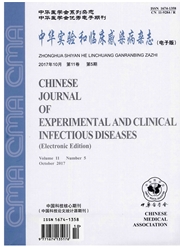

 中文摘要:
中文摘要:
目的:探讨胰腺癌患者术前血清中CA19-9与CEA表达情况对预后的影响。方法:回顾分析医院2012年1月~2013年12月128例胰腺癌患者临床病理资料,应用Kaplan.Meier法、Log—rank检验及Cox回归分析CA19-9和CEA水平与患者生存时间的关系。血清中CA19-9〉39U/mL,CEA〉4.7ng/mL被视为表达增高。结果:128例患者平均年龄为62岁,中位生存期为12.2月,其中CA19—9和CEA的表达水平增高的比例分别为78.1%,37.5%。CA19-9、CEA升高组患者的预后明显差于正常组(CA19-9,P=0.027;CEA,P=0.036)。Cox多因素回归分析显示淋巴结转移、CA19—9〉39U/mL、CEA〉4.7ng/mL是影响胰腺癌患者预后的独立因素。结论:术前CA19-9、CEA水平与胰腺患者生存时间密切相关,能有效评估患者的预后。
 英文摘要:
英文摘要:
Objective: To explore the use of preoperative CA19-9 and CEA serum levels as prognostic factors to affect survival in pancreatic cancer. Methods: A retrospective review of the clinical records of 128 patients with pancreatic adenocarcinoma between January, 2012 and December, 2013 was performed. Kaplan-Meier method, log-rank test and Cox regression analysis models were used to investigate the relationship between the levels of CA19-9 and CEA and survival outcome. The cut-off for CA19-9, CEA was 39 U/mL and 4.7 ng/mL. Results: The mean age of 128 patients was 62 years, and the median survival time was 12.2 months. The positive rate of CA19-9 and CEA were respectively 78.1%, 37.5%. Patients with high CA19-9 or CEA levels suffered a poorer prognosis than the individuals with normal levels (CA19-9, P=0.027; CEA, P=0.036). Cox logistic analysis revealed that lymphatic metastasis, CA19-9 〉39 U/mL and CEA 〉4.7 ng/mL were independent prognostic factors.Conclusion: The serum levels of preoperative CA19-9 and CEA were significant associated with survival time of pancreatic cancer patients, and could evaluate the prognosis of these patients.
 同期刊论文项目
同期刊论文项目
 同项目期刊论文
同项目期刊论文
 Downregulation of IFNG in CD4(+) T Cells in Lung Cancer through Hypermethylation: A Possible Mechani
Downregulation of IFNG in CD4(+) T Cells in Lung Cancer through Hypermethylation: A Possible Mechani Downregulation of IFNG in CD4+ T Cells in Lung Cancer through Hypermethylation: A Possible Mechanism
Downregulation of IFNG in CD4+ T Cells in Lung Cancer through Hypermethylation: A Possible Mechanism 期刊信息
期刊信息
